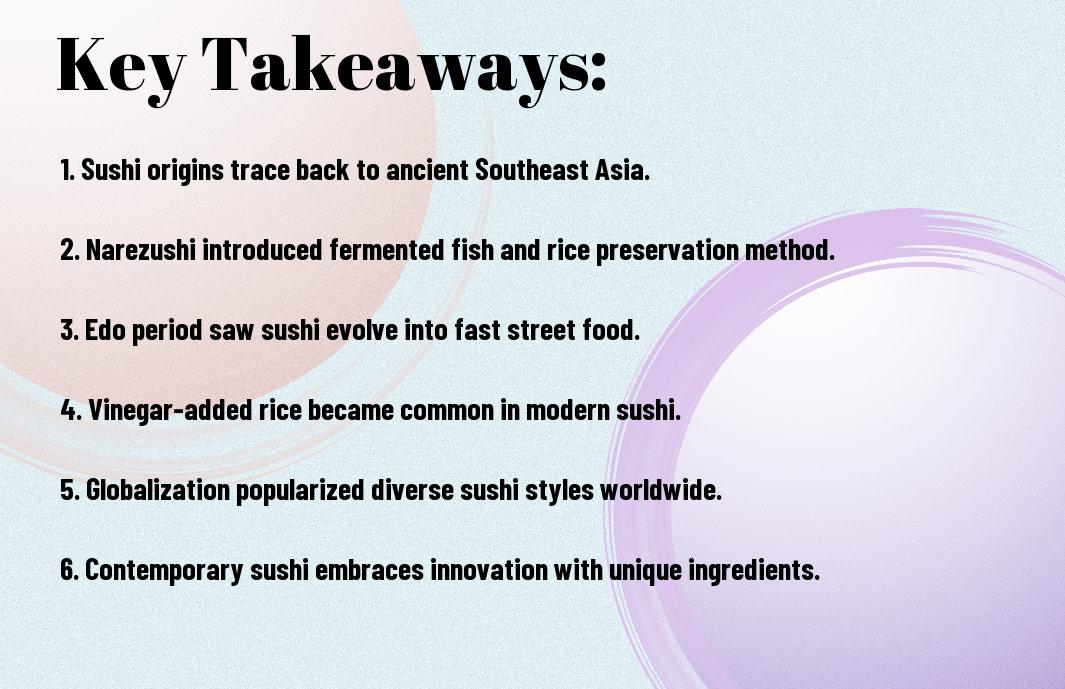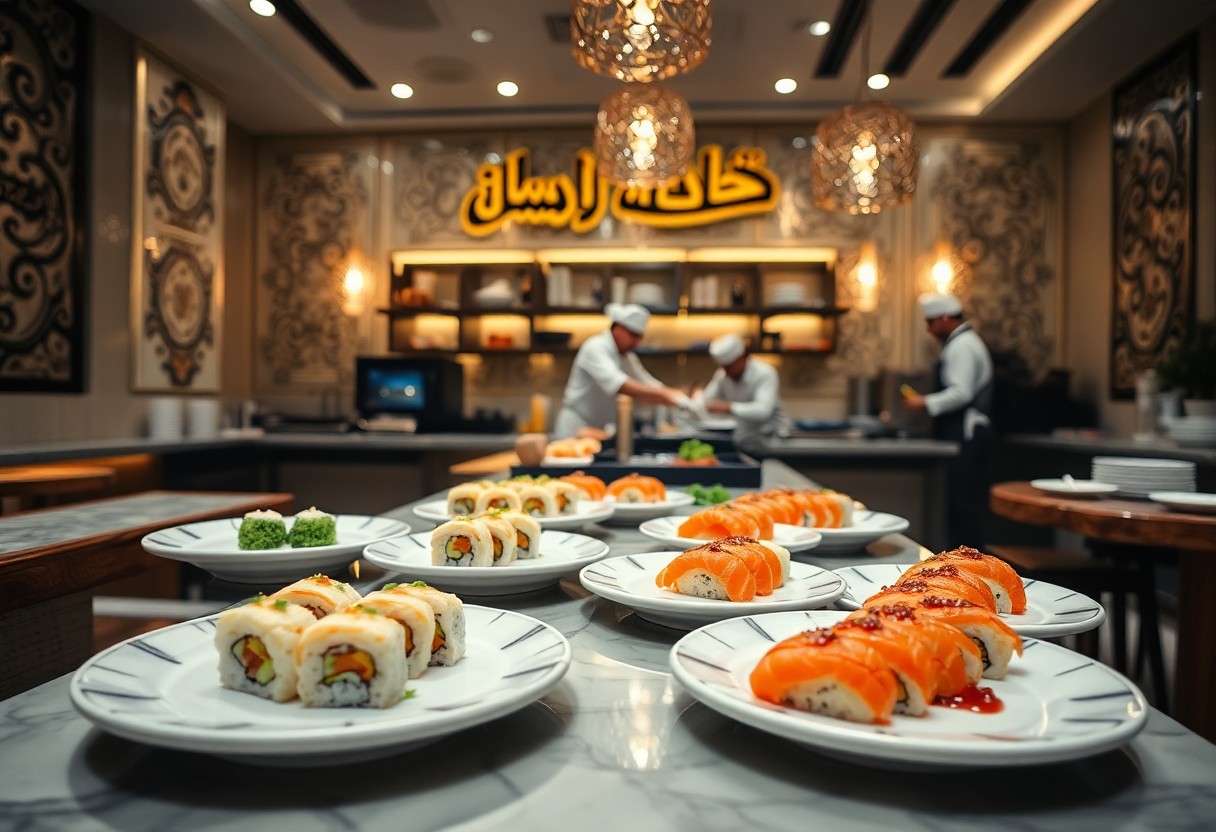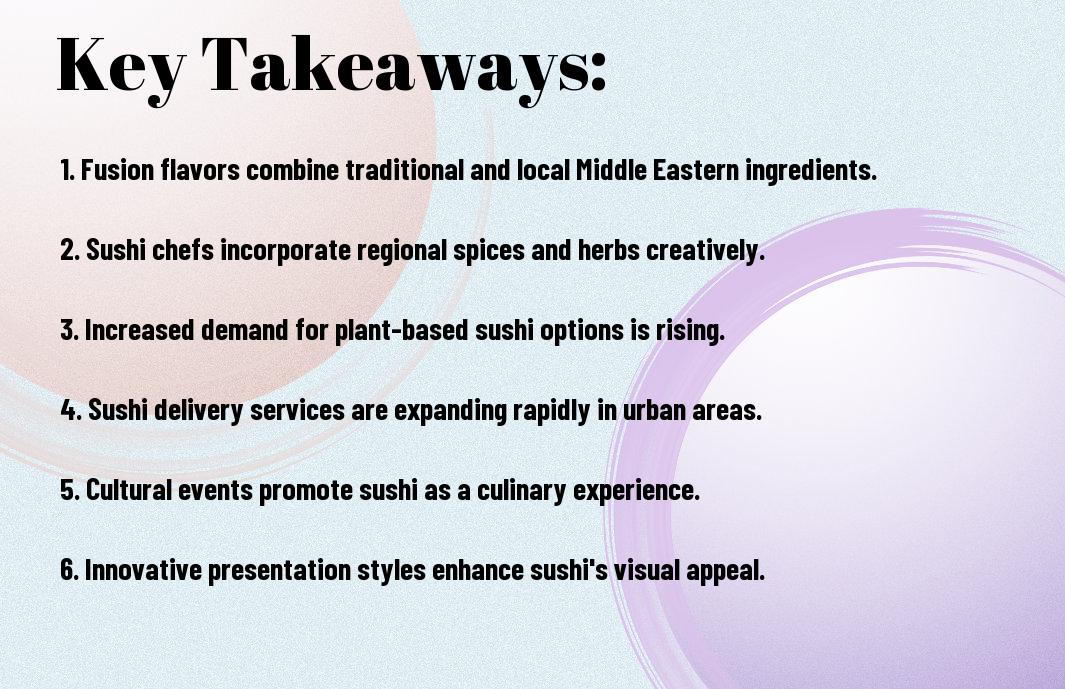Over the centuries, sushi has transformed from a simple preservation method into a culinary art form appreciated worldwide. As you explore this fascinating journey, you’ll discover how regional ingredients, cultural influences, and changing tastes have shaped sushi into the diverse offerings you enjoy today. This post probes into the rich history and evolution of sushi, highlighting key moments and styles along the way. For a more in-depth look, check out The Evolution of Sushi.
Key Takeaways:
- Origins: Sushi began as a method of preserving fish through fermentation in Southeast Asia, evolving significantly in Japan during the Edo period.
- Narezushi: This ancient form of sushi involved fermented fish wrapped in rice, showcasing early preservation techniques.
- Edomae Sushi: The development of Edomae sushi in Tokyo introduced fresh fish and vinegared rice, transforming sushi into a popular street food.
- Global Influence: Over time, sushi has adapted to various cultures, leading to unique variations like California rolls and fusion sushi dishes.
- Modern Trends: Today, sushi continues to innovate with gourmet ingredients and creative presentation, appealing to diverse palates worldwide.
The Origins of Sushi
The origins of sushi can be traced back centuries, evolving from a preservation method for fish to a culinary delight enjoyed around the world today. The foundational techniques were influenced by geography, culture, and the availability of ingredients, paving the way for various styles of sushi that reflect both tradition and innovation.
Ancient Roots in Southeast Asia
One of the earliest forms of sushi can be linked to Southeast Asia, specifically the practice of fermenting fish with rice. This method not only preserved the fish but also enhanced its flavor, establishing a unique relationship between consumption and preservation that would shape future sushi forms.
The Influence of Fermentation
Ancient methods of fermentation were vital in creating what would eventually evolve into sushi. By utilizing rice as a medium for preserving fish, communities were able to keep their catch edible for extended periods while imparting a distinctive taste that became highly valued in culinary practices.
Consequently, fermentation laid the groundwork for the sushi we know today. Instead of merely serving as a preservation technique, it transformed the flavor profiles of many dishes. This approach shifted culinary practices, allowing for the exploration of new ingredients and flavors, creating a rich tapestry of tastes that continuously inspire modern sushi chefs. Understanding these early processes helps you appreciate the artistry and cultural significance behind each roll and slice of sushi you enjoy.
The Evolution of Nigiri
While sushi has experienced numerous transformations, nigiri emerged as a prominent style in the Edo period of Japan. Originally created as a fast food option for the bustling streets of Tokyo, this hand-formed sushi features slices of fresh fish atop a mound of vinegared rice. The simplicity and artistry of nigiri reflect the delicate balance of flavors and textures that characterize Japanese cuisine. Nigiri continues to evolve, showcasing seasonal ingredients and innovative techniques, allowing you to explore new taste experiences while honoring tradition.
The Birth of Hand-Formed Sushi
Between the 1820s and 1830s, nigiri sushi began its journey as a street food in Edo (modern-day Tokyo). This new form of sushi was a response to urbanization, as people sought quick and delicious meals on the go. Vendors crafted hand-formed rice balls, topped with fresh fish and seafood, making it accessible to a busy populace. The convenience of nigiri allowed it to thrive, quickly becoming a beloved staple in Japanese cuisine.
Regional Variations in Japan
Sushi culture in Japan is rich with regional differences, particularly in how nigiri is prepared and served. Each area boasts its local specialties and preferred ingredients, reflecting the diverse resources available. You can experience variations such as the use of local fish in coastal regions, where seafood is freshly caught, or unique preparations infused with regional flavors. Cities like Osaka, Kumamoto, and Hokkaido each contribute distinct styles to the nigiri tapestry, offering a personalized sushi experience that showcases the culinary identity of each location.
It’s fascinating to note how regional variations in Japan shape the way you perceive and enjoy nigiri. For instance, in Osaka, you may encounter nigiri topped with an array of flavorful garnishes, while Hokkaido might present you with firmer rice paired with the freshest sashimi. As you travel through Japan, each bite of nigiri encapsulates the essence of its origin, allowing your palate to appreciate the local traditions and ingredients that make each piece unique, reinforcing the connection between food and culture.
Sushi’s Global Spread
Unlike its humble beginnings in Southeast Asia, sushi has transcended cultures and continents, captivating taste buds worldwide. As you explore its journey, you’ll find that the integration of sushi into Western cuisine has led to numerous interpretations and adaptations. For more insights, consider Uncovering The History of Sushi.
Introduction to the Western World
Global interest in sushi surged in the 20th century, particularly after World War II, when American soldiers stationed in Japan developed a taste for this delightful dish. As you explore the evolution of sushi in your local eateries, you’ll discover how restaurants began offering this Japanese fare, making it a staple in many Western dining spaces.
The Fusion of Flavors
Introduction of various ingredients and culinary techniques has led to creative sushi fusions that reflect your local palate. As sushi found its way into diverse kitchens, chefs began to experiment, incorporating regional flavors and ingredients. This innovation not only preserves the essence of sushi but also celebrates local culinary traditions.
Indeed, as you explore the wide array of sushi options available today, you’ll notice exciting fusions that blend traditional Japanese techniques with bold new flavors. From spicy tuna rolls to the inclusion of local favorites like avocado and cream cheese, these adaptations reflect a creative culinary dialogue that has enriched the sushi experience in your region. Each bite tells a story of cultural exchange, inviting you to indulge in a truly global cuisine.

Contemporary Sushi Trends
Keep your eyes on the evolving world of sushi as it embraces contemporary trends. From fusion flavors to varied presentation styles, sushi today reflects globalization and local influences. You’ll find incredible combinations that blend traditional Japanese techniques with ingredients from around the world, appealing to diverse palates while pushing the boundaries of this classic cuisine.
Creative Sushi Innovations
Creative sushi innovations are redefining the art of sushi-making. You may come across unique rolls that incorporate unexpected flavors or techniques, such as sushi tacos or sushi burgers, showcasing chefs’ imagination and culinary flair. These fresh takes invite you to experience sushi in novel ways, enhancing your enjoyment of this beloved dish.
Sustainability in Sourcing
Above all, sushi lovers today are increasingly mindful of sustainability in sourcing. You may find restaurants that prioritize eco-friendly practices, ensuring that the fish and ingredients they serve are harvested responsibly. This commitment not only protects marine ecosystems but also ensures high-quality and ethically sourced sushi for your dining experience.
Indeed, the movement towards sustainability in sourcing is gaining momentum among chefs and consumers alike. Many establishments are now transparent about their sourcing practices, favoring seafood that is caught seasonally and responsibly to minimize environmental impact. As a diner, you have the power to support these initiatives by choosing restaurants that prioritize sustainable options, which not only benefits our oceans but also enhances the quality and flavor of the sushi you enjoy.
Cultural Significance of Sushi
Once again, sushi transcends mere sustenance, embodying a rich cultural heritage that speaks to centuries of Japanese tradition and culinary artistry. Its evolution reflects not only advancements in cooking techniques but also the interplay between regional ingredients and seasonal availability. As you examine into the world of sushi, you uncover its role in social gatherings, rituals, and even its significance in Japanese diplomacy, illustrating how this simple dish carries profound cultural weight within society.
Sushi as an Art Form
For sushi chefs, each piece is more than just food; it is a canvas where craftsmanship and creativity converge. The meticulous preparation and presentation of sushi showcase their artistry, with attention to detail being paramount. As you explore sushi, you will appreciate how flavors, colors, and shapes come together to create a visually stunning and delicious experience, demonstrating that sushi truly is an art form.
Sushi in Popular Culture
Behind the scenes, sushi has gained immense popularity worldwide, becoming a symbol of gourmet dining and culinary sophistication. Its portrayal in films, television shows, and social media has elevated sushi’s status beyond traditional boundaries, enticing a global audience to embrace it. You may have noticed an increasing number of sushi bars and restaurants, which cater to diverse tastes and preferences, solidifying its place in contemporary dining culture.
For instance, sushi has appeared in popular movies, such as “Jiro Dreams of Sushi,” highlighting the dedication of sushi craftsmen and inspiring many to pursue sushi-making as both a hobby and profession. Furthermore, celebrity chefs have introduced innovative sushi creations, blending traditional techniques with global flavors to cater to evolving palates. You’ll find sushi-themed events, cookbooks, and even tattoo art celebrating this beloved dish, reflecting how deeply ingrained it has become in modern culture. As sushi continues to evolve, its influence in popular culture will undoubtedly grow, connecting you to a diverse community of sushi enthusiasts worldwide.

To wrap up
So, as you reflect on the evolution of sushi over centuries, you can appreciate how this beloved dish has transformed from a preservation method to a culinary art form embraced around the world. Each regional variation and modern adaptation tells a story of cultural exchange and innovation. By understanding its rich history, you deepen your connection to sushi, enriching your dining experience and appreciation for its artistry. Embrace the journey of sushi as it continues to evolve, bringing delight to your palate and inspiring new culinary adventures.
Q: How did sushi originate and what were its early forms?
A: Sushi’s origins can be traced back to Southeast Asia, where various forms of fermented fish were created using rice. This method, known as narezushi, involved packing fish in rice to preserve it through fermentation. Over time, this practice spread to Japan, where the locals began to consume the fish and discard the rice. Around the 18th century, the practice evolved into what we recognize as modern sushi with the introduction of vinegared rice, which allowed for freshness and the use of raw fish, significantly changing sushi’s culinary experience.
Q: In what ways did sushi change during the Edo period in Japan?
A: The Edo period, which lasted from 1603 to 1868, was a transformative time for sushi. During this era, sushi became more accessible and moved from being a labor-intensive preservation method to a quicker and more casual dining option. This led to the development of nigiri sushi, where hand-formed rice topped with fresh fish became popular. Street vendors in Edo (now Tokyo) capitalized on this trend, and sushi started being eaten as a fast food, signaling a shift towards the more immediate consumption of sushi as we see it today.
Q: How has sushi adapted in modern times, especially outside of Japan?
A: In contemporary settings, sushi has undergone various adaptations, particularly in Western countries where it has gained immense popularity. This has led to the creation of fusion styles, such as California rolls, which substitute traditional ingredients with local flavors, like imitation crab and avocado. Additionally, sushi bars have begun offering creative variations, spicy sauces, and different types of seafood that are not typically used in traditional sushi. This global evolution showcases how sushi has blended with diverse culinary traditions, making it a dynamic and continually evolving dish.

